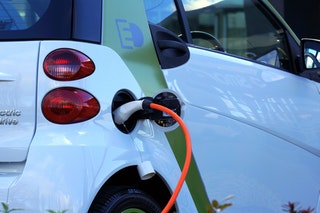Case Study: DAV Network + Los Angeles Transportation System
In 2016 Los Angeles became the first American city to show how shared self-driving vehicles will become part of its transportation network in the future.
The vision for Los Angeles includes a complete infrastructure overhaul that will allow autonomous vehicles to function fluidly throughout the city. The positive effects of this are numerous and far beyond the idea of just reducing traffic.
The cities Urban Mobility Study shows how streets can become narrower, sidewalks wider, the amount of green space can grow, parking garages will begin to disappear.
Los Angeles has created an approach that focuses on three core services and five policy considerations to make the proposed future a reality.
The three core services are data as a service, mobility as a service, and infrastructure as a service. The five policy areas will work together to provide the needs of these services.
For many of the goals, the technology has not yet been invented but a new project called DAV Network has the capabilities to change that. DAV is an open-source blockchain based platform that will allow autonomous vehicles to communicate, discover, and transact with each other without human supervision.
This case study will explore how DAV can address the needs of the Los Angeles Urban Mobility Study.
Data as a Service
Data as a Service is the rapid exchange of real-time condition and
service information between customers, service providers, government
and the supporting infrastructure to optimize safety, efficiency and
the transportation experience.
The DAV platform consists of a five-component technology stack that includes identity, discovery, communication, mission flow, and payments. The platform will allow 3rd party developers to access their API and SDKs to build apps that utilize the DAV Network.
Most important in the tech stack when offering Data as a Service are discovery, communication, and mission flow. With DAV 3rd party apps can utilize traffic data to predict routing methods and service needs.
A customer using DAV can book a trip home from a Dodger game that requires multiple types of transportation all in one move. The DAV platform will the customer to board and an autonomous city bus.The bus will take the passenger to a point near their destination. Prior to arrival, the bus will have sent off-chain discovery signals to privately owned (and available) autonomous vehicles.
After identifying an available vehicle, the bus will communicate directly with it to sync the bus drop off with the boarding of the private vehicle. The entire trip itinerary is managed by the mission flow stack.
In addition to the ride home, the passenger could simultaneously book a drone food delivery that will meet them at their destination. The multiple autonomous vehicles and mission flows will communicate with each other providing a seamless experience for the end user.
Mobility as a Service
In the Dodger game example, the passenger will book one trip using a mobile phone app in a fashion similar to booking through Uber even though the trip requires the use of multiple vehicles.Mobility as a Service centers on the customer; it provides a suite of
transportation mode options through a single platform and payment
system to simplify access to mobility choices.
The trip itinerary will be provided to the passenger much like a google maps itinerary is and the payment for the trip will be settled using DAV tokens. The DAV token payment will be divided amongst all providers via a smart contract.
Infrastructure as a Service
Infrastructure as a Service is the idea that the use and access of
public infrastructure should be subject to pay-as-you-go user fees
that more closely align the costs associated with providing the
infrastructure itself to how the infrastructure is being used.
Infrastructure is the key to the success of DAV because it is the foundation that will allow autonomous vehicle usage to grow. In Los Angeles, the cost of infrastructure will include charging stations for electric vehicles, possible specialized lanes for autonomous vehicles, the passage of favorable ordinances, and even parking spaces in a city that suffers from a lack of open street parking.
DAV approaches these infrastructure hurdles in an open fashion through an incentive program that rewards providers with DAV tokens.For autonomous passenger vehicles, this may mean that large shopping malls are rewarded for the use of their parking lots overnight, for drones charging stations can be built on top of warehouses, and cities are rewarded for passing special ordinances.
DAV rewards are purchased by the DAV Foundation off of open market exchanges, decreasing the supply as time passes. Those receiving incentives will only be able to utilize the tokens in the ecosystem as restrictive conditions can be placed on the tokens.
In Los Angeles, the city can be rewarded for the opening of autonomous vehicle lanes. The city can then use these tokens as incentives for private companies to build infrastructure as well. The inventive program will work to create the public/private hybrid that is required for a secure infrastructure.
The Timeline
The DAV Network timeline is a long one because it is addressing an issue that is in its infancy. DAV has the chance to solve a problem before it becomes one, the project is in position to be proactive rather than reactive in the way that traditional transportation systems have evolved.
The DAV Network will be launched in May 2018 and vehicles will begin communicating with each other in the fourth quarter of 2018. This timeline is much further ahead than the City of Los Angeles.
In the next two years, the City of Los Angeles plans to begin more in-depth studies into possible ordinances, data collections, and legality, existing infrastructure and shared mobility plans.
Within five years the city will implement smart fares for multi-modal systems, adopt APIs that allow data sharing, and create a unified wayfinding program.
Lastly, in six-plus years, the city is looking to leverage data to manage a more flexible transportation system with public and private service providers, create a universal fare system, and convert the public transit system to a fully automated fleet.
The staggered timelines between the readiness of DAV and the ability of cities to adapt will likely be repeated around the globe. DAV is providing itself with a headstart and will able to work together with cities on the ground floor as they build their infrastructure.
How to Participate in DAV
If you would like to use the DAV Network as a buyer or seller then you can purchase tokens on an exchange when available or via the token sale.
📅ICO Date: June 11, 2018.
📈Token Ticker: DAV
💵Token Price: 10,000 DAV/ETH
Total Supply at TGE: 1,771,428,571 DAV
Hardcap: $38 million
Amount for Sale: 40%
Token Type: ERC20
DAV Website ||Whitepaper ||Telegram || Bounty
Keep up with me:
Twitter ||Telegram Group || BitcoinTalk Profile

*This post contains a project overview not investment advice. As always do your own research before participating in a project of any fashion.




With humanity continuing to evolve and lives get busier, time will become a scarcity. As a result it is imperative technology continues to grow hand in hand with us. DAV is a great idea backed by a strong commitment to sticking to the ethos of helping people lives be much more efficient and easier.
The technology they are proposing could really instigate a revolution in future not only autonomous transportation, but all transportation itself.
Great article and continue to keep up the great work :)
DAV is going to benefit many people without them even knowing it. If the network that it creates can provide busy humans with even a few minutes of extra free time per day it will have a huge impact on the world.
I like that DAV is not designing the autonomous vehicles but instead focusing on the communication between vehicles.